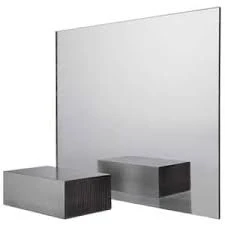

The Fascinating World of Transparent Mirror Glass
Transparent mirror glass, often referred to as one-way glass or reflective glass, is a remarkable innovation that bridges the gap between transparency and reflection. Its unique properties have found applications in various fields, from architecture and interior design to security and technology. This article delves into the characteristics, applications, and benefits of transparent mirror glass, showcasing its versatility and significance in contemporary society.
What is Transparent Mirror Glass?
Transparent mirror glass is a type of glass that possesses the unique ability to function both as a mirror and a window. On one side, it reflects light, creating a mirrored effect, while on the other side, it allows light to pass through, providing visibility. The key to this dual functionality lies in the coating applied to the glass. Typically, a thin layer of metal, such as silver or aluminum, is deposited on the glass surface, resulting in a semi-reflective quality. The degree of reflectiveness can be adjusted based on the needs of a particular application.
How Does It Work?
The functionality of transparent mirror glass is governed by the principles of light reflection and transmission. When light hits the coated surface, a portion is reflected back, creating a mirror effect. Simultaneously, the transparency of the glass allows some light to pass through, enabling visibility from the less reflective side. For optimal performance, it is essential for the lighting conditions to favor the reflective side; this is why transparent mirrors are often used in spaces where the light is controlled.
Applications of Transparent Mirror Glass
1. Architecture and Interior Design Transparent mirror glass is commonly used in modern architecture and interior design. Its ability to reflect light while allowing visibility makes it an excellent choice for creating illusionary spaces. Designers use it to make rooms appear larger and brighter, and it is often incorporated into partitions, doors, and windows in commercial buildings and homes. Additionally, it can effectively reduce the need for artificial lighting, thereby promoting energy efficiency.

2. Security and Privacy In security applications, transparent mirror glass serves as a tool for surveillance. It allows security personnel to monitor areas without being detected, making it an ideal solution for banks, museums, and retail stores. The reflective surface conceals observers while providing a clear view of the surroundings, contributing to enhanced safety.
3. Television and Displays The technology behind transparent mirror glass is also employed in various display technologies. Smart mirrors that connect to the internet are becoming prevalent in homes and retail spaces, offering interactive experiences while maintaining a sleek appearance. These mirrors can display information such as weather updates, news alerts, or even personal schedules, seamlessly blending functionality with aesthetic appeal.
4. Automotive Industry Transparent mirror glass is used in the automotive sector for rear-view mirrors and side mirrors. The reflective properties enhance visibility while reducing glare from headlights at night. Additionally, advanced technologies are being integrated into transparent mirrors, including heads-up displays that project essential information directly onto the glass, allowing drivers to maintain focus on the road.
Benefits of Transparent Mirror Glass
The advantages of transparent mirror glass are manifold. It allows for the creation of dual-purpose spaces, combining aesthetic appeal with functionality. The reduction in energy consumption through increased natural light use is another significant benefit. Furthermore, its application in security measures enhances safety without sacrificing design. Lastly, the innovative uses in technology and automotive sectors highlight its adaptability and potential for future developments.
Conclusion
Transparent mirror glass is a testament to modern engineering and design. Its ability to blend transparency with reflective properties opens up a world of possibilities across various industries. As we move towards a more interconnected and visually-driven society, the demand and relevance of transparent mirror glass will only continue to grow. Whether in creating a tranquil living space, enhancing security, or integrating technology into the daily routine, transparent mirror glass stands out as a functional and aesthetically pleasing solution, making it a pivotal element in the design and technology of the future.